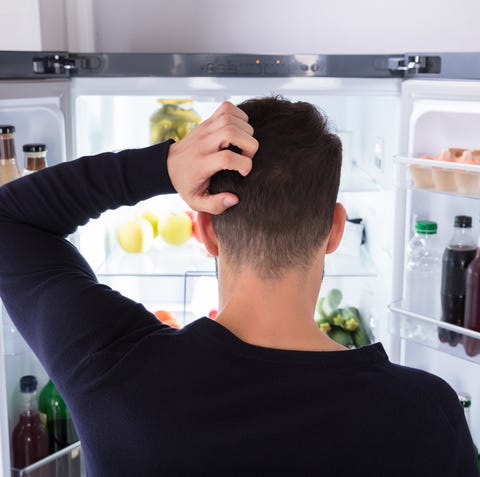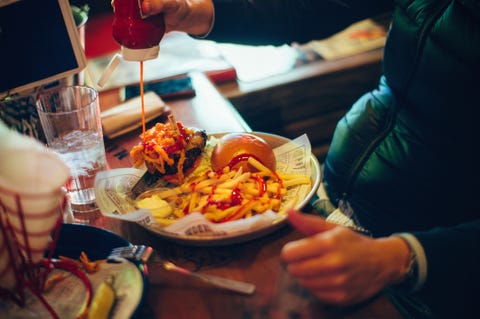
You know the routine when it comes to diet and exercise: Eat the right number of calories and nutrients each day to maintain muscle, avoid weight gain, and energize your workouts. So, how might your diet change based on active and rest days? Should you be scaling back on calories when you’re not blasting them during a workout? Does your body need more or less of certain foods when you’re in recovery mode?
Everyone’s different, and there’s no set standard of calories and nutrients that you should eat on a rest day versus an active day, explains Natalie Rizzo, MS, RD. But there are guidelines.
The Nutrients You Need When You’re Breaking A Sweat

Getty ImagesDrazen_
According to the International Society of Sports Nutrition, athletes who engage in intense cardio activity (running, HIIT, spin class) should aim for a 3:1 carbohydrate-to-protein ratio during recovery to stimulate glycogen re-synthesis and prepare for the next day’s workout.
“That’s extremely similar to an active day, where around 50-60% of calories will come from carbs and 20-25% come from protein,” says Rizzo.
If you do lower intensity workouts you might have a different ratio need. “For those who focus more on strength and lower intensity exercise, like strength training or yoga, the [carb-to-protein] ratio can be closer to 2:1. It’s important to still include carbs in your rest day nutrition plan,” she says.
The general rule is to let your stomach be you guide, not a calorie counting fitness tracker. “Since the amount of calories you actually burn on the days you exercise can vary greatly from what the even the more accurate chest strap monitors say, it’s best to let hunger, fullness and mindful eating guide your total energy consumption,” says Kelly Jones MS, RD, CSSD, LDN.
The Nutrients You Need When You’re Taking a Break

Getty ImagesGeorgijevic
The carbohydrate-to-protein ration should stay the same, and timing is important, says Jones. You still need carbs, fats, and protein, as they help in muscle repair, she explains. So, don’t think you should cut your calories or nutrients because you’re not being active.
“It takes 24-48 hours for the bulk of recovery to occur after a challenging workout, so it’s important on a rest day to consume enough carbohydrates to use as energy to recover, enough quality fats to bring inflammation down and support the heart and joints, and enough protein to repair body tissues,” she says.
You want to eat 20-30 grams of protein several times throughout the day, rather than eating very little at breakfast and 50 grams at dinner. This helps keep recovery constant, she explains.
“Many guys also assume they can cut back on protein on rest days, but in reality, the body continues to make protein almost 48 hours after a workout. Not eating enough protein or calories can hinder your muscle growth and athletic performance,” Rizzo explains.
Beware the Urge to Binge

Getty ImagesPhoto by Rafa Elias
While your diet and nutrient ratio shouldn’t change much between rest and active days, your hunger levels might fluctuate. “Some research points to the fact that when someone participates in a high energy workout, their hunger levels are usually suppressed immediately after the workout, so they don’t take in as many calories as they are burning off,” Rizzo says.
You may feel hungrier on a rest day because your body is craving to get in those calories that it burned off the previous day. Or, maybe your appetite hormones are finally starting to return to normal, she explains.
“For example, during exercise, the blood moves to your muscles and away from the gut, which can cause you to eat less. The next day, the body will regulate itself with an increase in the hormone ghrelin (which makes us feel hungry) and a decrease in the hormone leptin (which makes us feel satiated,” says Rizzo.
But don’t pig out. To avoid mindlessly eating, make sure you eat plenty of protein, fiber, and healthy fats to keep you feeling full. You also want to stay hydrated on off-days, even if you’re not sweating or thirsty. “Staying adequately hydrated on your day off is essential for reaping the benefits from tomorrow’s workout,” she says.
Plus, inflammation can incur after a workout and continue into a rest day, so eat plenty of antioxidant-rich foods, like beets, berries, and leafy greens to decrease inflammation, she adds.
The Idealized Rest Day in Food
“I wouldn’t alter rest days much, except maybe take away a pre-workout snack and post-workout recovery,” says Rizzo. This, of course, will vary based on the guy’s size, activity level, and type of activity they typically perform. (CrossFit will require more fuel than a casual jog.) Here’s an example of a rest day meal plan from Jones:
For Breakfast: Whole grain toast with avocado, 2 to 3 eggs, and some fruit.
Snack: If it will be longer than 4 hours until lunch, a snack with carbs and protein is important. Edamame with some dried fruit can do the trick.
For Lunch: Chicken and quinoa over greens with your favorite dressing, will tide you over,
Snack: Another snack similar in nutrients to the one recommended before lunch is important to have before dinner to continue recovery. An RxBar is easy and convenient, she says.
For Dinner: Salmon and a sweet potato with green beans is a balanced meal, and you can treat yourself to some dark chocolate after for dessert.
Source: Read Full Article
